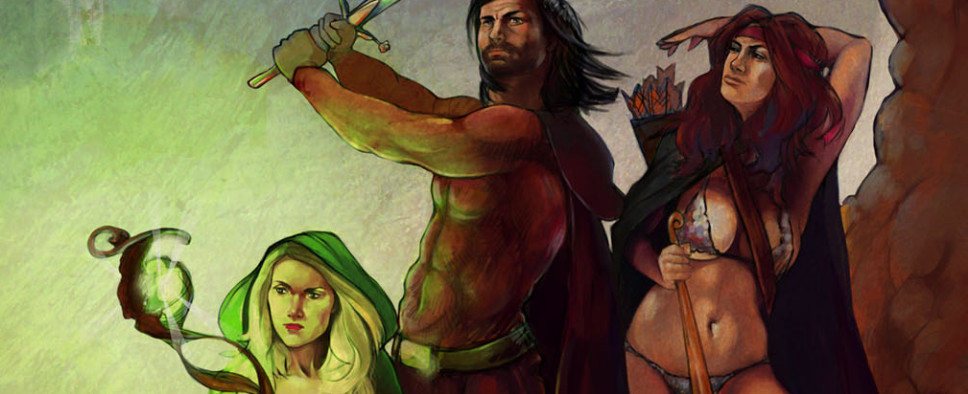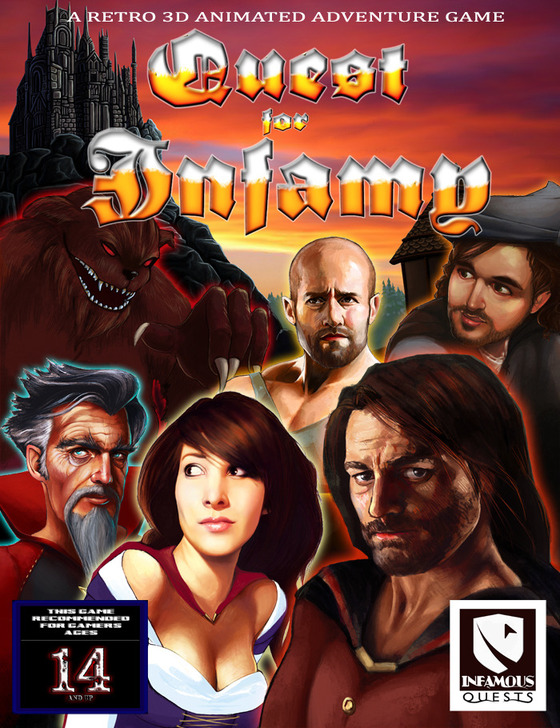Quest for Infamy Review
-
Category: ReviewsHits: 8224

Article Index
The word for today is "nostalgia," which, according to Merriam-Webster, is defined as the "pleasure and sadness that is caused by remembering something from the past and wishing that you could experience it again." In other words, nostalgia is the kick in many kickstarter projects, and it's the main reason we're starting to see a lot of '80s and '90s PC games make a comeback. So far the kickstarter games have mostly been adventures, but a wave of role-playing games is on the horizon, with Quest for Infamy leading the pack.
Quest for Infamy is a nod to Sierra Online's Quest for Glory franchise, which consisted of five games released between 1989 and 1998. The Quest for Glory games were built using Sierra's basic adventure game engine, but they added in combat, skills and attributes to form adventure-RPG hybrids, which were not only unique at the time, but they're still unique today. Better yet, the games had wonderful writing and humor, and so it's no surprise that people have shown a willingness to shell out their hard-earned cash to see more titles like them (and it's also a possible reason why Activision recently resurrected the Sierra brand and announced a new King's Quest game).
In Quest for Infamy you control a character named William Roehm. As the game opens up, you find yourself in a bedroom with the daughter of a baron -- and with the baron right outside trying to break down the door. You quickly announce that it isn't your fault -- that the girl "tricked" you -- and then you flee out an open window, leaving the girl to fend for herself. Yeah, that's the kind of character you're playing in the game. You're not out for glory; you're not even out for infamy that I noticed, but self-gratification and self-preservation, sure.
Weeks later you end up in the town of Volksville, which conveniently (and just like in Quest for Glory I) is surrounded by forests and other places for you to visit. The first thing you do in Volksville is choose one of the three classes for your character, either brigand (melee fighter), rogue, or sorcerer. This choice changes how you approach the game, how combat works for you, and which quests / puzzles you have to complete, and so it's a key cog in the game's replayability. I chose the brigand path, which allowed me to fight my way through most situations.
Quest for Infamy is played using an interface almost identical to the one employed by the VGA version of Quest for Glory I. That is, the world is presented as a series of "scenes" (normally one for each location), where you move your character using the mouse, and you interact with the scenes using the game's eight cursors, including one each for walking, sneaking, running, operating, examining, talking, fighting, and using an inventory object. The cursor isn't context-sensitive, so if you want to talk to somebody you have to switch to the talk cursor, and if you want to look at something you have to switch to the examine cursor, and so forth. There are three ways to switch cursors -- you can right click to cycle through them, you can move the cursor to the top of the screen and choose the icon for the one you want, or you can use a hotkey -- but still, it's not a very convenient system.
The town of Volksville contains most of the quest-givers and shopkeepers in the game, and also the mentor for your class. The mentor guides you through the early part of the game, and gives you a few quests unique to your class. For example, when playing a sorcerer, you have quests to unlock your spells, which require an assortment of odd items, including "flying water" (which is a reference to Quest for Glory I). By talking to Volksville's citizens, you also learn about a strange cult in the area, and the mysterious Eye of Jaager, which eventually lead to your main quest for the game.
While exploring the forests outside of Volksville, you sometimes encounter enemy creatures, including skeletons, bears and wolves. These encounters switch the game to a turn-based combat mode, where you can attack with your sword, block with your sword (which if successful prevents you from taking damage and also heals you a little), or make a special attack. Each class gets its own special combat move. After blocking three times, brigands get a power attack that is guaranteed to hit. Rogues can use a ranged "bladerang" that is also guaranteed to hit. And sorcerers get a variety of combat spells, including Flaming Vengeance and Ice Shards. There isn't any movement in the battles. You just attack or block or drink a health potion.
When an enemy dies, you usually find some money on the corpse, which allows you to buy quest items and new equipment. Characters only have three equipment slots -- one for a sword, one for bracers, and one for body armor -- but there are only three or four upgrades for each slot, and so equipment isn't a major part of the game. It just gives you something to spend your money on.
Like a lot of RPGs, the combat in Quest for Infamy starts out difficult and then gets easy. The main culprit here is the block skill. As you use your combat skills, you increase their ratings, but once you reach 100 with block, it's guaranteed to be successful, which means you can use it to heal yourself whenever you want -- and thus defeat any enemy in the game, even the end boss, regardless of your other skills or equipment. This completely deflates the RPG aspect of the game, leaving Quest for Infamy as mostly an adventure.
Luckily, the adventure parts of the game aren't too bad. There are a lot of puzzles to solve, and some of them are obscure enough that you won't figure them out right away. There are also usually multiple ways to solve the puzzles, depending on if you want to be direct or tricky, or spend money on items or try to gain them for free. Better yet, because some quests are only available to some classes, you find a lot of items that you can't do anything with, and they work as red herrings, which adventure games these days don't include as often as they used to. Red herrings are always good in adventures because they increase the number of possible things you can do, preventing you from simply solving puzzles through trial and error.
Sadly, though, Quest for Infamy has three major problems that prevented me from enjoying it very much. The first is that it's almost a carbon copy of Quest for Glory I, except with an anti-hero instead of a hero. That doesn't necessarily sound bad, but developer Infamous Quests even copied the interface, and while people often get nostalgic for old games, it's not because of the interfaces. I can still enjoy a game even if it has old VGA-style graphics, but I'd just as soon avoid not having tooltips and scrollbars and quicksaves and context-sensitive cursors and other modern amenities. Plus, the more a new game looks and plays like an old game, the less reason there is for me to recommend it over the old game. In this case, you can buy all five of the Quest for Glory games for about half the price of Quest for Infamy, and no doubt enjoy them more.
The second problem is the writing quality, which doesn't even come close to the level found in the Quest for Glory games. Worse, the tone of the game is dramatically different. I guess because you're playing an anti-hero, Infamous Quests didn't want to have "nice" jokes and instead made a beeline straight for the gutter. In the first hour I played, I saw references to masturbation, drug use, hookers, sex with dogs, and STDs; there's a beheading complete with splurting blood; your character is allowed to urinate on all sorts of things; and "shit" was used almost every other word for some characters. And you don't even want to know about the "bush" jokes.
Infamous Quests was also a little lazy in their writing. Adventures can often create a lot of humor from when players get stuck and start trying out random inventory objects in random places, but in Quest for Infamy you almost always get a generic "you can't do that" response -- or the game calls you an idiot, which is one of its favorite pastimes. I laughed a lot when I played the Quest for Glory games, but not so much with Quest for Infamy.
Finally, the voice acting in Quest for Infamy is sort of odd and annoying. For some reason almost all of the secondary characters use bizarre accents, and even the main character mumbles his lines. If it hadn't been for the subtitles, I wouldn't have known what he was saying about half of the time. Since Quest for Infamy is a budget title, I'm sort of guessing the voice actors weren't professionals, or maybe this was an attempt at humor that just didn't work for me. Luckily, you can turn off the voices if you want and not have to deal with them.
Overall, while I didn't hate Quest for Infamy, I thought it was a disappointing misfire. Developer Infamous Quests copied way too much from Quest for Glory I -- right down to recreating its 20-year-old interface -- but they weren't able to reproduce the most important thing about the game: a funny and enjoyable script. So I'm a little mixed in my recommendation. Quest for Infamy takes about 20 hours to complete, it has reasonable quality, and it even has replay value, but it's also barely amusing and it's much cruder than you might expect (I saw it listed with a Teen ESRB rating on one site, but there's no way that can be right). So you could buy Quest for Infamy or not, depending on how much the premise intrigues you, and since it's a budget title, it probably wouldn't be your worst purchase of the year.


